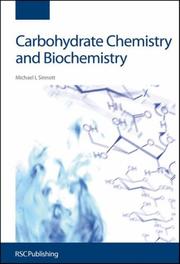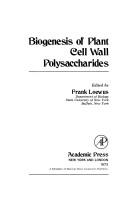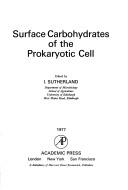| Listing 1 - 10 of 18 | << page >> |
Sort by
|
Dissertation
ISBN: 9789086492602 Year: 2009 Publisher: Leuven Katholieke Universiteit Leuven. Faculteit Wetenschappen
Abstract | Keywords | Export | Availability | Bookmark
 Loading...
Loading...Choose an application
- Reference Manager
- EndNote
- RefWorks (Direct export to RefWorks)
Deze thesis behandeld de kristallografische studie van enzymen van de glycoside hydrolase familie 32 (GH32) die belangrijk zijn in het sucrose en fructan metabolisme van planten. In het verleden werden reeds de driedimensionale (3D) structuren van een fructan exohydrolase (1-FEH IIa van C. intybus ) en van een celwand invertase (AtcwINV1 van A. thaliana ) opgelost. Om verder inzicht te krijgen in de specifieke verschillen tussen fructan exohydrolases en invertases werden hun complexen gegenereerd met verschillende substraten en inhibitoren. Daarmee kon onderzocht worden hoe deze moleculen exact gebonden zijn in de katalytische site en welke aminozuren een sleutelrol spelen in de substraatspecificiteit van de enzymen. De 3D structuren van 1-FEH IIa in complex met zijn substraat (1-kestose) en zijn inhitoren (fructose, DIM en sucrose) geven meer details waarom 1‑kestose een goed substraat is van 1-FEH IIa, terwijl sucrose een inhibitor is van het enzym. Daarnaast werden de 3D structuren opgelost van enkele sucrose/AtcwINV1 complexen. Deze toonden aan dat er verschillende bindingsmodi bestaan voor sucrose in GH32 enzymen en op welke manier de sucrose molecule gestabilizeerd kan worden in de actieve site. De 3D structuren van de 1-FEH IIa en AtcwINV1 complexen samen verschaffen zo belangrijke informatie omtrent de aminozuren betrokken in het complexe mechanisme van sucrose en fructan afbraak. Naast het werk op fructan exohydrolases en invertases, die hydrolases zijn, was het mogelijk om de eerste 3D structuur op te lossen van een plant enzym dat instaat voor de fructan biosynthese (FBE): 6-SFT van Pachysandra terminalis (Pt6SFT). Vervolgens werden het Pt6SFT/1-kestose complex en het Pt6SFT/ 6‑kestose complex opgelost. In dit laatste complex kon de acceptor bindingsplaats van het enzym gevisualiseerd worden. Op deze manier werden de specifieke aminozuren geïdentificeerd die een sleutelrol spelen in de acceptor specificiteit van Pt6SFT. Tenslotte, was het mogelijk de structuur van een tweede FBE te ontrafelen: een 1-SST van C. intybus . 1-FFT van hetzelfde species kon gekristalliseerd worden. Beide enzymen zijn sleutelenzymen in het inuline metabolisme van witloof. De structurele data uit deze thesis, sequentie alignments en mutagenese experimenten, maakte het mogelijk een model te ontwikkelen om de functionaliteit van plant GH32 enzymen te voorspellen, gebaseerd op hun aminozuursequentie. This thesis focuses on the structure determination and analysis of different enzymes within the glycoside hydrolase family 32 (GH32), which are important in sucrose and fructan metabolism in plants. Earlier, the 3D structures of a fructan exohydrolase (1‑FEH IIa from C. intybus ) and a cell wall invertase (AtcwINV1 from A. thaliana ) could be resolved. To gain further insights into the specific differences between fructan exohydrolases and invertases, the complexes with their substrates and inhibitors were generated to clarify how the molecules are exactly bound in the active site and which amino acid residues play a key role in the substrate specificity of the enzymes. The 3D structures of 1-FEH IIa in complex with its substrate (1‑kestose) and its inhibitors (fructose, DIM and sucrose) gave more details why 1‑kestose is a substrate of 1-FEH IIa, while sucrose acts as an inhibitor. In addition, several sucrose/AtcwINV1 complexes were resolved, showing different binding modi for sucrose in GH32 enzymes and how the sucrose molecule is stabilized in the active site. The 3D structures of these complexes together provide important information on the amino acid residues involved into the complex mechanism of sucrose and fructan degradation. Next to the work on FEHs and invertases, which are hydrolases, it was possible to resolve the first 3D structure of a plant fructan biosynthetic enzyme (FBE): a 6-SFT of Pachysandra terminalis (Pt6SFT). In addition, two 6-SFT complexes could be generated: a 1‑kestose and a 6‑kestose bound complex. The latter complex revealed the acceptor binding site of the enzyme, providing information on the amino acid residues important in the determination of its acceptor specificity. Finally, it was also possible to resolve the 3D structure of 1-SST of C. intybus and to crystallize 1-FFT of the same species, both key enzymes in the inulin metabolism of chicory roots. Combining the structural data, multiple sequence alignments and the mutagenesis experiments, a model has been put forward to predict the functionality of plant GH32 enzymes, based on their amino acid sequence.
577.152.2 --- 577.124 --- Academic collection --- Transferases --- Carbohydrate metabolism --- Theses --- 577.124 Carbohydrate metabolism --- 577.152.2 Transferases
Multi
Abstract | Keywords | Export | Availability | Bookmark
 Loading...
Loading...Choose an application
- Reference Manager
- EndNote
- RefWorks (Direct export to RefWorks)
Dissertation
ISBN: 9789086491346 Year: 2007 Publisher: Leuven Katholieke Universiteit Leuven. Faculteit Wetenschappen
Abstract | Keywords | Export | Availability | Bookmark
 Loading...
Loading...Choose an application
- Reference Manager
- EndNote
- RefWorks (Direct export to RefWorks)
Structuur-functie analyse van Glycoside Hydrolase Familie 32 (GH32) plant invertasen en fructan exohydrolasen Fructanen zijn sucrose-afgeleide polymeren van fructose die voorkomen in ongeveer 15% van de planten. De afbraak van fructanen wordt gekatalyseerd door fructan exohydrolasen (FEHs), een reactie waarbij telkens één terminale fructosyleenheid wordt afgesplitst en water als acceptor wordt gebruikt. Alle gekende FEHs zijn zeer specifiek voor fructanen (Fru-Fru verbinding) als donor substraat en zijn niet in staat sucrose (Glc-Fru verbinding) af te breken. De afbraak van sucrose gebeurt door invertasen. Plant FEHs zijn sterk verwant aan celwand invertasen en dit op zowel moleculair als structureel niveau. Er wordt dan ook algemeen aangenomen dat deze enzymen evolutionair sterk verwant zijn. Ze worden samen gegroepeerd in de familie 32 van Glycoside Hydrolasen (GH32). Zowel FEHs als invertasen kunnen beschouwd worden als fructosyltransferasen die enkel verschillen in donorsubstraat specificiteit. Tijdens dit doctoraatsonderzoek werden drie aspecten onderzocht met betrekking tot de verschillen in substraatspecificiteit tussen de verschillende types van GH32 afbraakenzymen. In een eerste deel werd aandacht besteed aan de binding en afbraak van sucrose door invertasen. Tot op heden is het onduidelijk welke aminozuren bepalen of sucrose danwel een fructan wordt gebruikt als donorsubstraat. De ontrafeling van de 3D-structuur van Arabidopsis thaliana celwand invertase 1 (AtcwINV1) en Cichorium intybus 1-FEH IIa, zijn bepalend geweest om verdere inzichten te verschaffen in het fundamentele verschil tussen beide sterk verwante enzymen. Door plaatsgerichte mutagenese experimenten op zowel AtcwINV1 als Beta vulgaris 6-FEH, kon worden aangetoond dat Asp239 en Trp47 een belangrijke rol spelen in de binding en hydrolyse van sucrose. Bovendien vertoonde de D239A mutant een specifieke 1-FEH activiteit. Deze bevindingen bevestigen in sterke mate de algemene hypothese dat FEHs ontstaan zijn uit een celwand invertase-achtige voorouder door een beperkt aantal mutaties. Algemeen kan worden gesteld dat de aan- of afwezigheid van een Asp239 homoloog bepaalt of een GH32 enzym sucrose danwel fructan als donor substraat gebruikt. Op basis hiervan kan de functionaliteit van een nieuw of niet-gekarakteriseerd enzym uit de celwand invertase/FEH groep voorspeld worden en kan dit beschouwd worden als een waardig en snel alternatief voor functionele karakterisatie. In een tweede deel werd de sucrose inhibitie van FEHs onderzocht. Net zoals 1-FEH IIa worden verschillende FEHs zeer sterk geïnhibeerd door sucrose. Op basis van de 3D-structuur van 1-FEH IIa in complex met het substraat 1-kestose en inhibitor sucrose kon verder worden onderzocht waarom sucrose bindt als een inhibitor en niet kan worden gehydrolyseerd. Een vergelijking van alle gekende GH32 en GH68 structuren in complex met hun substraat of inhibitor toonde aan dat de eindstandige fructosyleenheid telkens op een identieke manier bindt in de -1 subpositie van de active site. Mutagenese studies toonden aan dat de sterk geconserveerde Trp82 van de WSGSAT regio cruciaal is voor een stabiele binding van substraat en inhibitor. Opvallend is dat de positie van Trp82 in 1-FEH IIa sterk verschilt, wat de binding van sucrose in een alternatieve inhibitor configuratie mogelijk maakt. De specifieke orientatie van Trp82 wordt bepaald door de afwezigheid van de interactie met een hydrofoob aminozuur, wat kon bevestigd worden door plaatsgerichte mutagenese experimenten. Alle FEHs die door sucrose worden geïnhibeerd zijn gekenmerkt door de afwezigheid van zulk een hydrofoob aminozuur. In een laatste deel werd dieper ingegaan op de binding van langere inuline en levan ketens in de verschillende types van FEHs. Een groot probleem in dit onderzoek is de afwezigheid van 3D-structuren van zowel een 6-FEH als een 1-FEH in complex met deze substraten. Desondanks kon op basis van mutagenese studies de groeve tussen de twee structurele domeinen van 1-FEH IIa geïdentificeerd worden als de inuline bindingsplaats. In celwand invertasen en 6-FEHs is deze bindingsplaats geblokkeerd door de aanwezigheid van een glycosylketen. De introductie van een N-glycosylatieplaats in 1-FEH IIa verhindert de binding en afbraak van inuline. Door de afwezigheid van een 6-FEH structuur, is het onduidelijk hoe een levan keten bindt in 6-FEHs. Wel kan er met vrij grote zekerheid gesteld worden dat dit substraat op een andere manier en op een andere plaats bindt dan een inuline keten in 1-FEHs. Plaatsgerichte mutagenese en modeling studies wijzen in de richting van een alternatieve levan en 6-kestose bindigsplaats. Bovendien zijn er sterke aanwijzingen dat het verschil in substraat specificiteit tussen β, 2-1 en β, 2-6 specifieke FEHs (gedeeltelijk) bepaald wordt door Trp82. Ter conclusie kan worden gesteld dat dit doctoraatsonderzoek de eerste belangrijke inzichten aanreikt betreffende de verschillen in substraatspecificiteit tussen de verschillende types van GH32 afbraakenzymen. Enkele zeer belangrijke aminozuren voor de binding, in zowel de substraat als inhibitor configuratie, als de hydrolyse van sucrose konden worden geïdenficeerd. Ook werd de binding van inuline en levan in 1-FEH en 6-FEHs gedeeltelijk opgehelderd en konden de eerste inzichten verworven worden in het verschil in substraatspecificiteit tussen β, 2-1 en β, 2-6 specifieke FEHs. Structure-function analysis of Glycoside Hydrolase Family 32 (GH32) plant invertases and fructan exohydrolases Fructans are sucrose based polymers of fructose occuring in about 15% of the flowering plants. The degradation of fructans is catalyzed by fructan exohydrolases (FEHs), releasing one terminal fructosyl at a time using water as an acceptor. All FEHs purified so far were found to be unifunctional enzymes being very specific for fructans (Fru-Fru linkage) as donor substrate and unable to degrade sucrose (Glc-Fru linkage). Sucrose is hydrolyzed by invertases. Plant FEHs are closely related to cell wall invertases at the molecular and structural level and are grouped in the Glycoside Hydrolase Family 32 (GH32). Both FEHs and invertases can in fact be considered as fructosyltransferases only differing in donor substrate specificity. The high levels of sequence similarity between these enzymes reveal an important evolutionary relationship. In this doctoral study, we focussed on three main subjects dealing with the differences in substrate specificity between the different types of GH32 family hydrolases. In a first part, the binding and hydrolysis of sucrose in invertases was investigated. Until now, it remained unclear which amino acid residues determined whether sucrose or fructan is used as a donor substrate in the hydrolysis reaction of the glycosidic bond. The three dimensional structure determination of Cichorium intybus 1-FEH IIa and Arabidopsis thaliana cell wall invertase 1 (AtcwINV1) was important to gain further insights into the specific differences between these two types of closely related enzymes. Site-directed mutagenesis studies on AtcwINV1 and Beta vulgaris 6-FEH demonstrated an important role for Asp239 and Trp47 in sucrose binding and hydrolysis. Moreover, an AtcwINV1 D239A mutant acted as a FEH preferentially degrading 1-kestose, strongly supporting the general idea that FEHs could have evolved from a cell wall invertase ancestor by few mutational changes. In general, GH32 family enzymes containing an Asp239 functional homologue have sucrose as preferential donor, while enzymes lacking this homologue use fructans as their donor substrate. Asp239 and Trp47 are proposed as reliable determinants for the identification of non characterized members within the group of cell wall invertases/ FEHs. This predictive tool is a rapid way to confirm the invertase functionality of enzymes catalogued as such and can be considered as an important alternative for functional characterization. Secondly, the inhibitory effect of sucrose on FEHs was examined. Sucrose was found to be a strong inhibitor for many, but not all, FEHs including chicory 1-FEH IIa. The three dimensional structure determination of chicory 1-FEH IIa in complex with its preferential substrate 1-kestose and its inhibitor sucrose, provides further insights why sucrose acts as an inhibitor in 1-FEH IIa and not as a substrate. Comparison of several GH32 and GH68 protein structures in complex with their substrates, reveals that the terminal fructosyl unit is always bound in a very similar way at the -1 subsite. Apparently, the presence of a highly conserved Trp82 homologue (WSGSAT region) is crucial for the stabilization of the substrate in the active site, as confirmed by site-directed mutagenesis studies. Interestingly, in chicory 1-FEH IIa, this Trp residue has a different orientation, most probably allowing sucrose to bind in an alternative inhibitor configuration. This different orientation is determined by the absence of a stacking hydrophobic residue, as observed for all sucrose inhibited FEHs and confirmed by site-directed mutagenesis studies. A final part deals with the binding of inulin and levan in FEHs. Unfortunately, no three dimensional structures of chicory 1-FEH IIa in complex with higher DP inulin could be obtained. However, site-directed mutagenesis studies on chicory 1-FEH IIa strongly support the presence of an inulin binding cleft between the two structural domains. Introduction of an N-glycosylation site near this cleft most probably prevents inulin binding and degradation. Since the presence of such a glycosyl chain blocking this cleft is highly conserved among 6-FEHs, the binding of levan occurs most probably in a different way and at a different location. Although any structural data on 6-FEHs are lacking so far, modeling studies and some site-directed mutagenesis experiments are indicative for the presence of an alternative levan and 6-kestose binding site. Moreover, the difference in substrate specificity between β, 2-1 and β, 2-6 hydrolyzing FEHs seems to be (partly) determined by the Trp82 residue. In conclusion, this doctoral study provides the first insights into the fundamental differences in substrate specificity between the different types of GH32 hydrolases. Some critical amino acids with respect to sucrose binding, in both substrate and inhibitor configuration, and hydrolysis could be identified. Also some first insights on the difference in substrate specificity between β, 2-1 and β, 2-6 hydrolyzing FEHs were obtained.
Dissertation

ISBN: 9789086490851 Year: 2007 Publisher: Leuven K.U.Leuven. Faculteit Wetenschappen
Abstract | Keywords | Export | Availability | Bookmark
 Loading...
Loading...Choose an application
- Reference Manager
- EndNote
- RefWorks (Direct export to RefWorks)
Academic collection --- 581.1 --- 577.124 --- 577.152.3 --- Plant physiology --- Carbohydrate metabolism --- Hydrolases. Hydrolitic fermentations --- Theses --- 577.152.3 Hydrolases. Hydrolitic fermentations --- 577.124 Carbohydrate metabolism --- 581.1 Plant physiology
Book
ISBN: 9781891127533 Year: 2007 Publisher: Saint Paul AACC int.
Abstract | Keywords | Export | Availability | Bookmark
 Loading...
Loading...Choose an application
- Reference Manager
- EndNote
- RefWorks (Direct export to RefWorks)
Carbohydrates --- chemical structure --- technical properties --- 577.124 --- 664 --- Carbs (Carbohydrates) --- Biomolecules --- Organic compounds --- Glycomics --- 664 Production and preservation of solid foodstuffs --- Production and preservation of solid foodstuffs --- 577.124 Carbohydrate metabolism --- Carbohydrate metabolism

ISBN: 0470150475 Year: 1976 Publisher: Hillsdale, N.J. Erlbaum
Abstract | Keywords | Export | Availability | Bookmark
 Loading...
Loading...Choose an application
- Reference Manager
- EndNote
- RefWorks (Direct export to RefWorks)

ISBN: 1847558011 9781847558015 9780854042562 0854042563 Year: 2008 Publisher: Cambridge Royal society of chemistry
Abstract | Keywords | Export | Availability | Bookmark
 Loading...
Loading...Choose an application
- Reference Manager
- EndNote
- RefWorks (Direct export to RefWorks)
This monograph is aimed at providing researchers new to the subject with information on the structure and mechanisms in the chemistry, biochemistry or processing of carbohydrates. The book contains everything the reader needs to know about a non-synthetic carbohydrate research project. It gives excellent coverage of carbohydrate chemistry and biochemistry, particularly including the principles of reactivity in the process industries, such as pulp, paper and food. It also employs use of the same concepts to describe enzymic and non-enzymic reactivity.
Carbohydrates. --- Organic compounds. --- Compounds, Organic --- Organic chemicals --- Carbon compounds --- Carbs (Carbohydrates) --- Biomolecules --- Organic compounds --- Glycomics --- Carbohydrates --- 547.917 --- 577.114 --- 577.124 --- 577.124 Carbohydrate metabolism --- Carbohydrate metabolism --- 577.114 Carbohydrates. Monosaccharides. Polysaccharides --- Carbohydrates. Monosaccharides. Polysaccharides --- 547.917 Carbohydrates

ISBN: 0124553508 0323152465 1299473822 9780124553507 Year: 1973 Publisher: New York: Academic press,
Abstract | Keywords | Export | Availability | Bookmark
 Loading...
Loading...Choose an application
- Reference Manager
- EndNote
- RefWorks (Direct export to RefWorks)
Polysaccharides --- Plant cell walls --- Synthesis --- Congresses --- 576.314 --- 577.124 --- 581.17 --- -Polysaccharides --- -Biopolymers --- Saccharides --- Cell walls, Plant --- Plant cells and tissues --- Cell membrane --- Carbohydrate metabolism --- Physiology of the cell --- -Congresses --- -Cell membrane --- 581.17 Physiology of the cell --- 577.124 Carbohydrate metabolism --- 576.314 Cell membrane --- -581.17 Physiology of the cell --- Biopolymers --- Synthesis&delete& --- Polysaccharides - Synthesis - Congresses --- Plant cell walls - Congresses

ISBN: 0126778507 9780126778502 Year: 1977 Publisher: London Academic press
Abstract | Keywords | Export | Availability | Bookmark
 Loading...
Loading...Choose an application
- Reference Manager
- EndNote
- RefWorks (Direct export to RefWorks)
Microbial polysaccharides --- Bacterial cell walls --- Prokaryotes --- 577.124 --- 579.234 --- Monera --- Procaryotae --- Procaryotes --- Prokaryonta --- Prokaryotae --- Prokaryotic protists --- Microorganisms --- Microbial polymers --- Polysaccharides --- Bacterial membranes --- Cell walls, Bacterial --- Bacteria --- Cell membranes --- Carbohydrate metabolism --- Cell wall. --- Bacterial cell walls. --- Microbial polysaccharides. --- Prokaryotes. --- 579.234 Cell wall. --- 577.124 Carbohydrate metabolism --- Cell wall
Dissertation
ISBN: 9058081125 Year: 1999 Publisher: Wageningen : Wageningen Universiteit,
Abstract | Keywords | Export | Availability | Bookmark
 Loading...
Loading...Choose an application
- Reference Manager
- EndNote
- RefWorks (Direct export to RefWorks)
Solanum tuberosum --- Tubercule --- Tubers --- Organe de réserve --- Storage organs --- Glucide --- Carbohydrates --- Métabolisme des glucides --- Carbohydrate metabolism --- 633.491 --- 581.144.2 --- 577.124 --- Potato. Solanum tuberosum --- Roots. Subterranean nutrition organs --- Theses --- 577.124 Carbohydrate metabolism --- 581.144.2 Roots. Subterranean nutrition organs --- 633.491 Potato. Solanum tuberosum
| Listing 1 - 10 of 18 | << page >> |
Sort by
|

 Search
Search Feedback
Feedback About UniCat
About UniCat  Help
Help News
News